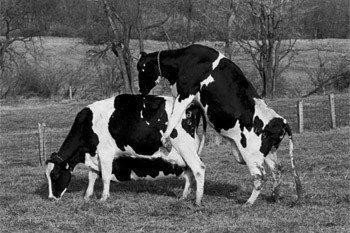BREEDING OF DAIRY CATTLE
BREEDING OF DAIRY CATTLE
The objective of dairy production is to have milk all the time, hence the need to have a calf every year. A heifer gets to sexual maturity at 7 months of age when it starts showing signs of heat and the heat repeats every 21 days. A heifer is supposed to be bred at 16 months of age or when it attains a minimum of 250 kg body weight.
Signs of Heat
- The cow becomes restless
- The vulva is swollen, moist and red inside
- Frequent bellowing and urination
- Mucous discharges from the vulva
- The animal on heat mounts others or stands to be mounted
- The animal is off feed or reduce feed intake.
Breeding Methods
- Natural
This is where a bull is used to mate with the cow/heifer for reproduction.

Advantages of use of a bull for breeding.
- There is no need for heat detection by the farmer
- In most cases the bull does not miss the heat period.
Disadvantages of use of a bull for breeding.
- High risk of sexually transmitted disease
- Expensive in maintaining the bull
- Chances of inbreeding are high where uncontrolled breeding is practiced and if there are no proper records.
- Artificial insemination (AI)
This is the process of depositing semen into the uterus by use of insemination gun.

Advantages of Artificial insemination
- The farmer is at liberty to choose semen from the preferred bull
- The cost of semen is cheap compared to maintaining a bull
- Sexually transmitted diseases are prevented
- Efficient use of bulls with desirable traits
- The farmer is able to choose the sex of the offspring.
Disadvantages of Artificial Insemination
- Requires well trained personnel in AI
- It uses specialised equipment which is expensive and not readily available
- Farmer should have knowledge in detecting heat and effective reporting.
Hints on Artificial Insemination.
- Farmers are supposed to patiently observe their animals 3 times a day for 20 minutes to detect heat
- If an animal starts heat in the morning it should be inseminated in the late afternoon and if it starts in the afternoon the right time to inseminate is the following morning
- If possible insemination can be made twice in order to increase chances of pregnancy
- If 21 days have gone after insemination and the animal does not come on heat it could be a sign that the animal is pregnant. This could be confirmed at about 3 months by conducting pregnancy diagnosis
- Farmers should always record the subsequent expected date/dates of heat
- Gestation period for cattle is 280 days (nine months)
- A cow should be bred again around 60 days or second heat after calving.


